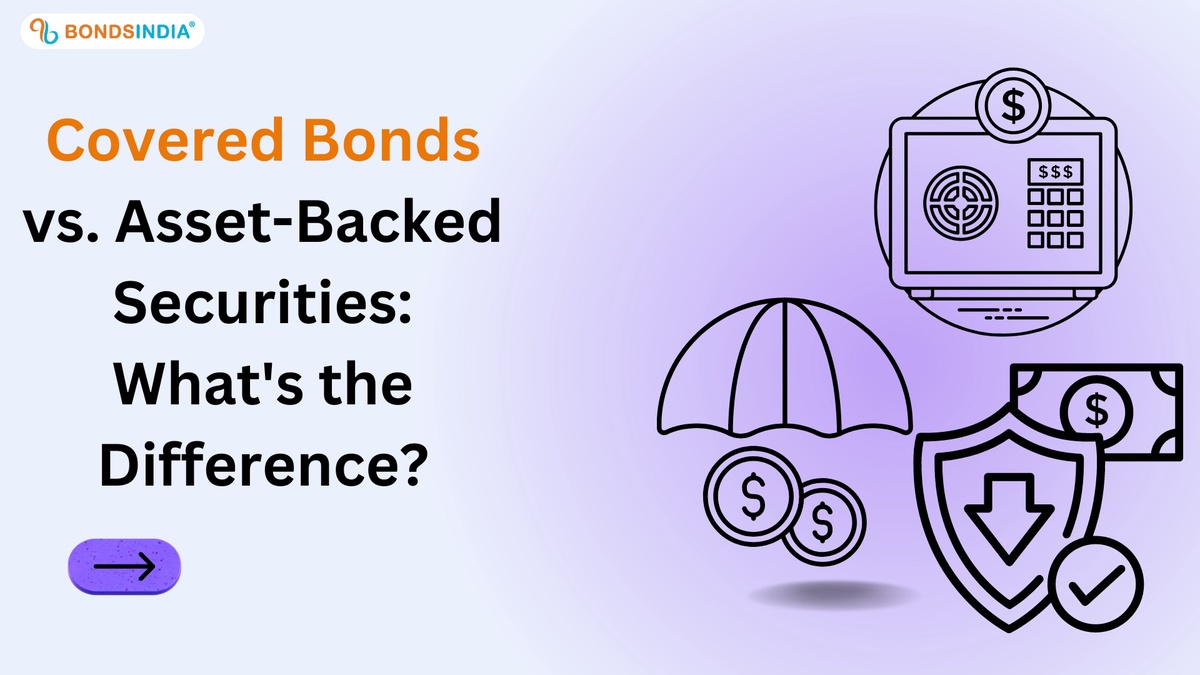The world of finance is full of complex terms and concepts that can easily confuse even the most seasoned investors. Two of those concepts are covered bonds and asset-backed securities (ABS). While they may seem similar, there are crucial differences between them. In this blog post, we will explore what covered bonds and ABSs are, how they work, and ultimately help you understand which one might be right for your investment goals. So get ready to dive into the exciting world of fixed-income securities as we uncover the mystery behind these two popular financial instruments.
Introduction to Covered Bonds
A covered bond is a type of debt security that is backed by a pool of assets, typically mortgages. The main difference between covered bonds and asset-backed securities (ABS) is that the issuer of covered bonds remains on the hook for repaying investors even if the asset pool defaults.
Covered bonds have been around for centuries, with the first ones being issued in Germany in the early 1800s. Today, they are widely used in Europe and are gaining popularity in other markets, such as Canada and Australia.
The key benefits of investing in covered bonds include:
– Low default risk: Covered bonds are considered to be one of the safest investments out there. This is because the issuer is required to maintain a high-quality portfolio of assets and to keep a buffer of extra assets on hand to cover any potential losses. In addition, covered bonds typically have higher credit ratings than ABS.
– High yield: Covered bonds typically offer higher yields than other types of safe investments, such as government bonds. This makes them an attractive option for income-seeking investors.
– Access to underlying collateral: If the issuer defaults on its obligations, investors will have direct access to the underlying pool of assets (e.g., mortgages). This provides greater security than investing in ABS, where investors would only be able to recover their investment through the bankruptcy process.
Introduction to Asset-Backed Securities
Asset-backed securities (ABS) are a type of investment security that is collateralized by a pool of assets. The assets in the pool can be anything from student loans to credit card debt to auto loans. ABS are often referred to as "securitizations" because they are created through a process of securitization, which is the process of pooling together assets and then selling them as securities.
The main advantage of asset-backed securities is that they offer investors a higher degree of safety than other types of investments. This is because the underlying assets act as collateral for the securities, which means that if the issuer defaults on the securities, investors can still recover their investment by seizing and selling the assets in the pool.
Asset-backed securities are also attractive to investors because they offer higher yields than most other types of investments. This is because the issuer typically pays a higher interest rate on asset-backed securities than on other types of debt, such as corporate bonds.
Another advantage of asset-backed securities is that they tend to be very liquid, which means that they can be easily bought and sold in the secondary market. This liquidity allows investors to quickly exit an investment if necessary without having to wait for the underlying assets to be sold.
Key Differences Between Covered Bonds and ABS
As the name suggests, asset-backed securities (ABS) are bonds that are backed by physical assets. In contrast, covered bonds are not backed by any specific assets, but rather by the issuer's general creditworthiness. This means that if the issuer defaults on the bond, investors have a claim on the issuer's assets.
Another key difference between covered bonds and ABS is that covered bonds are typically issued by banks, while ABS are often issued by non-bank financial institutions. This is because banks tend to have greater access to capital markets and a more diversified range of assets than non-bank financial institutions.
Finally, covered bonds tend to be more expensive than ABS. This is because they offer investors a higher level of protection against default.
- Risk Exposure of Investors
Investors in covered bonds and asset-backed securities are both exposed to credit risk, interest rate risk, and liquidity risk. However, the type of exposure differs between the two securities.
Covered bonds are typically backed by a portfolio of mortgage loans or public sector debt, which means that investors are exposed to the risk of default on these underlying assets. However, because covered bonds are senior debt instruments, investors are first in line to receive payment in the event of a default. This means that they are less likely to suffer losses than investors in asset-backed securities, which are typically subordinate debt instruments.
Asset-backed securities are also exposed to interest rate risk and liquidity risk. Interest rate risk refers to the possibility that changes in interest rates will affect the value of the security. For example, if rates rise and the security is paying a fixed rate of interest, its value will decline. Liquidity risk is the risk that an investor will be unable to sell their security at a fair price or may not be able to find a buyer at all. This is more likely to happen with asset-backed securities than with covered bonds because there is often less market demand for them.
- Credit Strengths
Covered bonds have a number of advantages over asset-backed securities. For starters, covered bonds are typically senior debt, meaning that they have priority in bankruptcy proceedings. This gives investors in covered bonds greater security than those in asset-backed securities.
Another key advantage of covered bonds is that they are backed by a pool of assets, rather than being backed by individual loans. This makes it easier for investors to assess the underlying credit risk and provides greater protection in the event of defaults.
Finally, covered bonds tend to have longer maturities than asset-backed securities, which can provide stability for investors seeking long-term income.
- Maturity Structure
When it comes to covered bonds vs asset-backed securities, one key difference is the maturity structure. Covered bonds typically have a longer average maturity than asset-backed securities. That’s because covered bonds are issued by banks, which tend to have longer-term liabilities. And since the issuer is on the hook for repayment, investors are more likely to get their money back even if there’s a downturn in the market.
Asset-backed securities, on the other hand, have a shorter average maturity. That’s because they’re backed by assets with shorter lifespans, such as credit card receivables or auto loans. And since the issuer is not directly responsible for repayment, investors are more likely to lose money if there’s a market downturn.
- Prepayment Rights
Covered bonds and asset-backed securities are both types of debt securities, but there are some important differences between the two. Covered bonds have a higher credit rating than asset-backed securities, meaning that they are less risky for investors. Covered bonds also have prepayment rights, which means that the issuer can redeem the bonds before they mature. Asset-backed securities do not have prepayment rights.
- Categories of Assets Secured
- Mortgage-backed securities
Mortgage-backed securities are one of the most common asset classes used in covered bonds and asset-backed securities. They are created when a pool of mortgages is sold to an investor, and the payments on the mortgages are passed through to the investor. The investor receives interest and principal payments as borrowers make their mortgage payments.
Mortgage-backed securities can be further broken down into pass-through securities and collateralized mortgage obligations. Pass-through securities are the simplest form of a mortgage-backed security, and they are exactly what they sound like: the payments from the mortgage pool are passed through to the investor with no further structure or enhancement. Collateralized mortgage obligations (CMOs) involve more complex structures, in which the cash flows from the underlying mortgage pool are divided into different tranches. Investors in different tranches receive interest and principal payments at different times, depending on the specific structure of the CMO.
- Auto loans
Auto loans are another type of asset that can be securitized in both covered bonds and asset-backed securities. In an auto loan securitization, a group of auto loans is bundled together and sold to investors. The cash flows from these loans are then passed through to investors, who receive periodic interest and principal payments as borrowers make their loan payments. Similar to mortgage-backed securities, auto loan securitizations can be structured as either pass-through transactions or as collateralized debt obligations
Pricing Implications for Investors
As the name suggests, covered bonds are backed by a pool of assets, typically mortgage loans. These asset-backed securities are then sold to investors in the form of bonds. The key difference between covered bonds and asset-backed securities is that covered bonds are senior debt instruments, while asset-backed securities are subordinated debt instruments. This means that if the underlying pool of assets defaults, holders of covered bonds will be first in line to receive payment, while holders of asset-backed securities will only receive payment after covered bondholders have been paid in full.
This structural difference has important implications for pricing. Covered bonds typically trade at a spread to government bonds (the so-called "risk premium"), while asset-backed securities trade at a spread to both government and corporate bonds. The higher risk premium on asset-backed securities reflects the fact that they are subordinate debt instruments with greater credit risk.
Conclusion
Investing in either covered bonds or asset-backed securities requires an understanding of how both investment instruments operate. Both can provide investors with a secure form of investments as long as they understand the risks and rewards associated with each instrument. Covered bonds have the advantage of being partially secured by mortgages, while asset-backed securities are subject to credit performance risk due to their underlying assets, which can vary depending on the issuer and security type. Ultimately, it is important for investors to weigh their options carefully before deciding whether to invest in covered bonds or asset-backed securities.


No comments yet